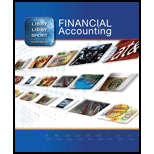
Financial Accounting, 8th Edition
8th Edition
ISBN: 9780078025556
Author: Robert Libby, Patricia Libby, Daniel Short
Publisher: McGraw-Hill Education
expand_more
expand_more
format_list_bulleted
Textbook Question
Chapter 11, Problem 8MCQ
Which statement regarding dividends is false?
- a. Dividends represent a distribution of corporate profits to owners.
- b. Both stock and cash dividends reduce
retained earnings . - c. Cash dividends paid to stockholders reduce net income.
- d. None of the above statements are false.
Expert Solution & Answer
Want to see the full answer?
Check out a sample textbook solution
Students have asked these similar questions
Calculate stricklers cash conversion cycle?
Given answer
can you please solve this
Chapter 11 Solutions
Financial Accounting, 8th Edition
Ch. 11 - Prob. 1QCh. 11 - Prob. 2QCh. 11 - Prob. 3QCh. 11 - Differentiate between common stock and preferred...Ch. 11 - Explain the distinction between par value and...Ch. 11 - Prob. 6QCh. 11 - Prob. 7QCh. 11 - Prob. 8QCh. 11 - Define treasury stock. Why do corporations acquire...Ch. 11 - How is treasury stock reported on the balance...
Ch. 11 - What are the two basic requirements to support the...Ch. 11 - Prob. 12QCh. 11 - Prob. 13QCh. 11 - Prob. 14QCh. 11 - Prob. 15QCh. 11 - Prob. 16QCh. 11 - Prob. 1MCQCh. 11 - Prob. 2MCQCh. 11 - Prob. 3MCQCh. 11 - Prob. 4MCQCh. 11 - Prob. 5MCQCh. 11 - Prob. 6MCQCh. 11 - Prob. 7MCQCh. 11 - Which statement regarding dividends is false? a....Ch. 11 - Prob. 9MCQCh. 11 - Prob. 10MCQCh. 11 - Prob. 1MECh. 11 - Prob. 2MECh. 11 - Prob. 3MECh. 11 - Prob. 4MECh. 11 - Determining the Effects of Treasury Stock...Ch. 11 - Determining the Amount of a Dividend Cole Company...Ch. 11 - Prob. 7MECh. 11 - Prob. 8MECh. 11 - Prob. 9MECh. 11 - Prob. 10MECh. 11 - Prob. 1ECh. 11 - Prob. 2ECh. 11 - Prob. 3ECh. 11 - Prob. 4ECh. 11 - Prob. 5ECh. 11 - Prob. 6ECh. 11 - Prob. 7ECh. 11 - Prob. 8ECh. 11 - Prob. 9ECh. 11 - Prob. 10ECh. 11 - Prob. 11ECh. 11 - Prob. 12ECh. 11 - Prob. 13ECh. 11 - Prob. 14ECh. 11 - Prob. 15ECh. 11 - Prob. 16ECh. 11 - Prob. 17ECh. 11 - Prob. 18ECh. 11 - Prob. 19ECh. 11 - Prob. 20ECh. 11 - Prob. 21ECh. 11 - Prob. 22ECh. 11 - Prob. 23ECh. 11 - Prob. 24ECh. 11 - Prob. 25ECh. 11 - Prob. 1PCh. 11 - Prob. 2PCh. 11 - Prob. 3PCh. 11 - Prob. 4PCh. 11 - Prob. 5PCh. 11 - Prob. 6PCh. 11 - Prob. 7PCh. 11 - Prob. 8PCh. 11 - Prob. 9PCh. 11 - Prob. 10PCh. 11 - Prob. 11PCh. 11 - Prob. 12PCh. 11 - Prob. 1APCh. 11 - Prob. 2APCh. 11 - Prob. 3APCh. 11 - Prob. 4APCh. 11 - Prob. 1ACOMPCh. 11 - Prob. 1BCOMPCh. 11 - Prob. 1CCOMPCh. 11 - Prob. 1DCOMPCh. 11 - Prob. 1CPCh. 11 - Prob. 2CPCh. 11 - Prob. 3CPCh. 11 - Prob. 4CPCh. 11 - Prob. 5CPCh. 11 - Prob. 6CPCh. 11 - Prob. 1CC
Knowledge Booster
Learn more about
Need a deep-dive on the concept behind this application? Look no further. Learn more about this topic, accounting and related others by exploring similar questions and additional content below.Similar questions
arrow_back_ios
SEE MORE QUESTIONS
arrow_forward_ios
Recommended textbooks for you
- Principles of Accounting Volume 1AccountingISBN:9781947172685Author:OpenStaxPublisher:OpenStax College
 Auditing: A Risk Based-Approach (MindTap Course L...AccountingISBN:9781337619455Author:Karla M Johnstone, Audrey A. Gramling, Larry E. RittenbergPublisher:Cengage Learning
Auditing: A Risk Based-Approach (MindTap Course L...AccountingISBN:9781337619455Author:Karla M Johnstone, Audrey A. Gramling, Larry E. RittenbergPublisher:Cengage Learning


Principles of Accounting Volume 1
Accounting
ISBN:9781947172685
Author:OpenStax
Publisher:OpenStax College

Auditing: A Risk Based-Approach (MindTap Course L...
Accounting
ISBN:9781337619455
Author:Karla M Johnstone, Audrey A. Gramling, Larry E. Rittenberg
Publisher:Cengage Learning

Earnings per share (EPS), basic and diluted; Author: Bionic Turtle;https://www.youtube.com/watch?v=i2IJTpvZmH4;License: Standard Youtube License